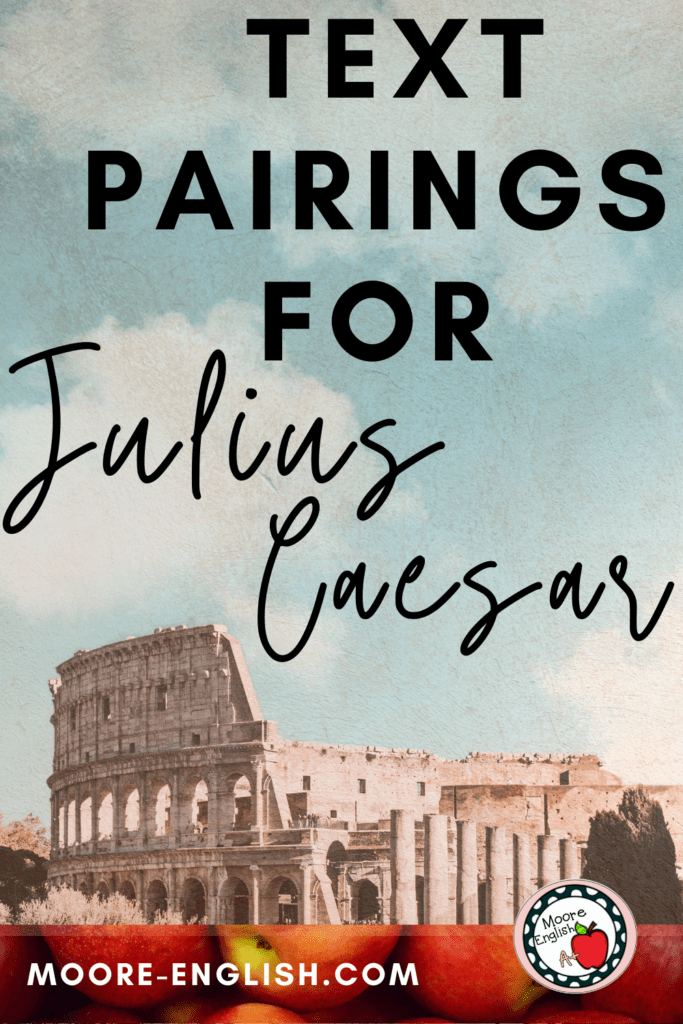My sophomores are getting ready to read Julius Caesar by William Shakespeare. This is one my favorite classroom dramas!
Students love the political intrigue, we act everything out, and the play is a great vehicle for reviewing story elements and introducing rhetorical devices!
Since I don’t teach a traditional short story or poetry unit, I’m always looking for opportunities to incorporate short works. In the past, I’ve struggled to find text pairings for Julius Caesar. But after years of searching, brainstorming, tweaking, and experimenting, I finally have 4 surprising and unexpected nonfiction text pairings for teaching Julius Caesar.
This post this post may contain affiliate links. Please read the Terms of Use.
Speeches to Pair with Julius Caesar
More than anything, Julius Caesar is remembered for its impactful rhetoric. To help students activate prior knowledge about rhetoric, I often use this quick rhetoric card sort.
While the best-known orator in Julius Caesar is Mark Antony, his use of rhetoric is purely vengeful, manipulative, and self-serving. After students read Antony’s funeral oration (grab my free version today!), I want to present students with an alternative view of rhetoric. Not all rhetoric is nefarious.
With that in mind, I chose two famous speeches from American history.
First, JFK’s Inaugural Address is a classic in the canon of American rhetoric. Like Antony’s funeral speech, JFK’s speech provides students with plenty of opportunities to analyze rhetoric. In addition, both Antony and JFK speak to times of governmental change and transition. Obviously, JFK’s goals are different from Antony, but this provides students with a chance to contrast their purposes. Finally, JFK’s memorable “Ask not what your country can do for you…” suits Brutus and his motives, which can lead to an interesting conversation. The JFK Presidential Library has free resources for teaching this text!
Second, FDR’s Four Freedoms speech is another incredible example of rhetoric at work. While this is a longer and more complex text than JFK’s speech, the setting and occasion of FDR’s speech creates an interesting parallel to the chaos and tension of Shakespeare’s Rome. In addition, FDR’s speech makes an argument for protecting democracy, which is one of Brutus’ key motives. Similarly, the four freedoms central to FDR’s speech all have a place in Rome where they are largely under threat from Julius Caesar, Antony, and, eventually, Octavius. The FDR Presidential library also has free resources for this text!
As a way to wrap up any of these texts, students can apply these Rhetoric Task Cards.
Essays to Pair with Julius Caesar
While JFK and FDR provide students with a different view of rhetoric, there are also some great essay options to pair with Julius Caesar.
First, “Civil Disobedience” by Henry David Thoreau speaks to Brutus’ motives. Each year, students and I have a conversation about whether or not the death of Julius Caesar constitutes civil disobedience. In this discussion, students use excerpts from “Civil Disobedience” to support their opinion. Then, we end with a conversation about what modern-day civil disobedience requires (ie-not murder). Read it here.
Lastly, “Words and Behavior” by Aldous Huxley is a challenging essay in which Huxley critiques the use of rhetoric to advocate for war. While this is a difficult text for students, Huxley’s criticisms of the dangers of rhetoric apply nicely to Cassius’ and Antony’s impassioned speeches. In addition, Huxley writes against the backdrop of World War II, which allows students to compare his historical context to Shakespeare’s Rome. Finally, Huxley’s writing also addresses the Roman mob in a way none of the other texts on this list do. Read it here.
Honorable Mention: Artwork as Text
While nonfiction is an unexpected text pairing for Julius Caesar, there are plenty of pieces of artwork that depict his death. In an effort to approach RA.7 (the most challenging Common Core standard), I’ve put together four artistic depictions of his death.
With these images, students can compare and contrast the different ways artists visualize the death of Julius Caesar. This is a great opportunity to help students evaluate the effect medium has on meaning.
My Favorite Julius Caesar Resources!
At the end of the day, all of these text pairings help me teach Julius Caesar. They help students learn to evaluate rhetoric and to synthesize across texts and mediums.
However, there are times when my drama unit is crunched, so I have just enough time for the play and nothing else. When that happens, I turned to my Abridged and Modified Julius Caesar. I originally designed this resource for students struggling with the length and complexity of the original text. It’s also a great time saver!
Overwhelmingly, this is my favorite Julius Caesar resource! It also pairs well with my free anticipation guide and these 18 journal prompts!















